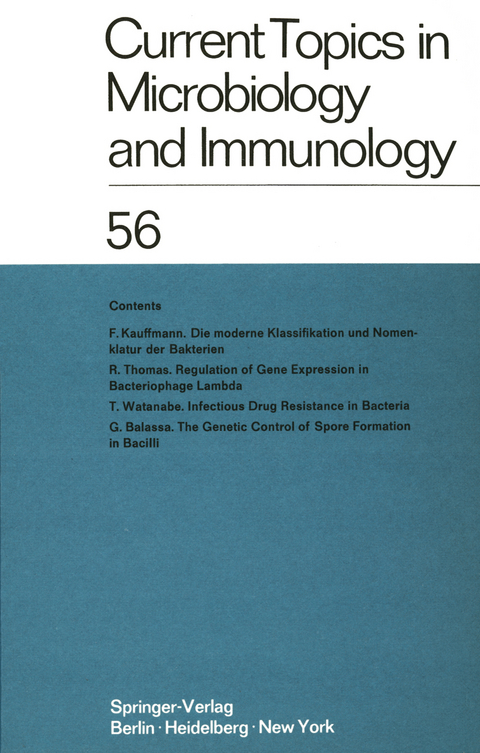
Current Topics in Microbiology and Immunology / Ergebnisse der Mikrobiologie und Immunitätsforschung
Seiten
2011
|
1. Softcover reprint of the original 1st ed. 1971
Springer Berlin (Verlag)
978-3-642-65243-1 (ISBN)
Springer Berlin (Verlag)
978-3-642-65243-1 (ISBN)
The expression of many bacterial genes adapts itself in an almost in stantaneous and reversible way to specific environmental changes. More specifically, the concentration of a number of metabolites, a function of the amounts of enzymes involved in their synthesis or degradation, in turn retroacts on the rate of synthesis of these enzymes. The genetic bases for this regulation were established by JACOB and MONOD (1961). These authors also showed how the known elements of these regulatory mechanisms could be connected into a wide variety of circuits endowed with any desired degree of stability, in order to account for essentially irreversible processes like differentiation (MONOD and JACOB, 1961). The general principles used by JACOB and MONOD in their study of negative regulation were extended to positive regulation by ENGLESBERG et al. (1965). An independent approach permitted the discovery of positive controls in temperate bacteriophages (see below, III). Each control operation is mediated by a pair of complementary genetic elements (hereafter called "control cell"): a control gene which produces a l control (or regulator) protein and a control site which is the target for the regulator protein. Negative control means that the control protein (repressor) prevents gene expression. One deals with positive control when the control protein (activator) is necessary for this expression. It has become apparent that, as initially postulated by JACOB and MONOD, control of gene expression operates, at least to a large extent, at the transcriptional level.
Die moderne Klassifikation und Nomenklatur der Bakterien.- Regulation of Gene Expression in Bacteriophage Lambda.- Infectious Drug Resistance in Bacteria.- The Genetic Control of Spore Formation in Bacilli.- Author Index.
| Erscheint lt. Verlag | 15.11.2011 |
|---|---|
| Reihe/Serie | Current Topics in Microbiology and Immunology |
| Zusatzinfo | IV, 226 p. |
| Verlagsort | Berlin |
| Sprache | englisch |
| Maße | 170 x 244 mm |
| Gewicht | 414 g |
| Themenwelt | Medizin / Pharmazie ► Allgemeines / Lexika |
| Naturwissenschaften ► Biologie | |
| Schlagworte | Bacteria • Biology • Cell • Environment • genes • Immunität • immunology • Microbiology • Protein |
| ISBN-10 | 3-642-65243-3 / 3642652433 |
| ISBN-13 | 978-3-642-65243-1 / 9783642652431 |
| Zustand | Neuware |
| Haben Sie eine Frage zum Produkt? |
Mehr entdecken
aus dem Bereich
aus dem Bereich
medizinischer Grundwortschatz und Fachwörterlexikon für Pflegeberufe
Buch | Softcover (2022)
Börm Bruckmeier Verlag
19,00 €
Kleines Lexikon - medizinische Fachbegriffe, Fremdwörter und …
Buch | Softcover (2021)
Börm Bruckmeier (Verlag)
19,00 €


